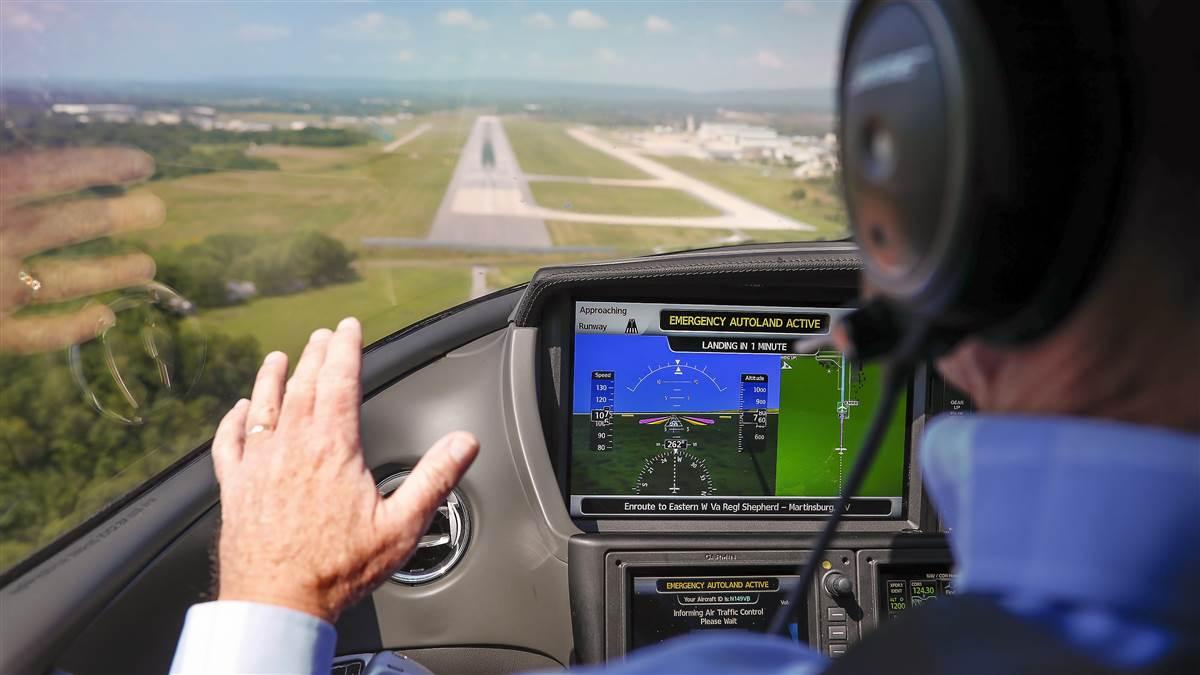Technology: This changes everything
Garmin’s Autoland system will change the way we fly

The system now capable of landing a Cirrus SF50 or Piper M600 on its own, or at the touch of a single button, is meant for rare cases of pilot incapacitation. But industry experts say that once the system proves itself in the real world, its technology is sure to expand to normal flight operations—and that has the potential to change everything.
Once fully automated approaches and landings are widely adopted, these advances could follow:
- The technology that enables it, such as radar altimeters and autothrottles, will become less expensive.
- Full authority digital engine controls (FADEC) for piston aircraft engines will become more widespread.
- Single-pilot crews are likely to be approved for larger and more complex aircraft, including airliners.
- Airplanes capable of autonomous approaches and landings won’t have ceiling and visibility requirements at thousands of U.S. runways.
- Hand-flown instrument approaches and landings will become rare events that pilots practice in simulators and training flights but seldom use in day-to-day flying.
- Some existing aircraft will get retrofit kits that enable autonomous approaches and landings.
- Single-engine aircraft that lack autothrottles will get “auto-glide” software that directs them to the nearest runway in case of engine failure.
“The Garmin system as it now exists is there to back pilots up in emergency situations,” said Brad Hayden, founder and CEO of Robotic Skies, a New Mexico company with a global network of repair stations for drones. “The real paradigm shift will happen when the pilot is there for times in which the automated system fails.”
And that tipping point, Hayden said, may not be far away.
Its technology is sure to expand to normal flight operations—and that has the potential to change everything.“We’re entering an automated era, and people are adjusting to it,” he said. “I recently rode in a Tesla in Southern California and the vehicle essentially drove itself. I was uncomfortable at first, but it took about an hour to get to our destination, and by the time we arrived I was totally cool with it.”
Self-driving cars have much more complex problems to solve in a far less predictable and fast-changing environment than aircraft navigating the airways.
Each self-driving Tesla, for example, has multiple cameras and sensors, and can share information with a network that distributes it among tens of thousands of vehicles. When a Tesla hits a pothole, for example, the car remembers and avoids the pothole by taking another route or driving in a different lane, and tells its network so other cars know, too.
The Garmin Autoland system is self-contained within each airplane. The next step in automation, Hayden said, is datalink communication with other aircraft and air traffic controllers.
“That technology is being used in the unmanned world right now,” he said. “Technology is being shared more and more between manned and unmanned aviation, and eventually those distinctions will go away. It’s all just aviation.”
Mike Busch, founder of Savvy Aviation, an aviation firm that does a great deal of engine data collection and analysis (see “Savvy Maintenance: Hot Seat,” p. 100), said the safety benefits of automated flight are compelling. About 75 percent of aviation accidents are caused by pilot error, a figure that has remained stubbornly unchanged for decades.
“It’s easy for automation to do a better job of flying airplanes than humans,” Busch said. “Look at our record.”
“Technology is being shared more and more between manned and unmanned aviation, and eventually those distinctions will go away. It’s all just aviation.” —Brad HaydenA modern, digital autopilot updates about five times per second and never gets tired, or hungry, or wakes up in a bad mood. Huge investments in self-driving cars and mass production of miniature cameras and other sensors eventually will remake aviation. “I’ve got sensors in my car that look in all directions every moment that it’s on the road,” Busch said. “It doesn’t have blind spots. I’ve got good technology in my airplane, too, but I don’t see everything around me.”
The FAA’s recent move to performance-based standards has led to a major shift that includes the use of modern, relatively low-cost non-TSO avionics in standard category airplanes. Busch said he expects manufacturers to use experimental category aircraft to explore autonomous approaches and landings and bring unmanned technology to GA.
“You can’t gather the data that demonstrates these systems are safer than what we’ve got without flying them,” he said. “The experimental category allows for that kind of work.”
Ric Peri, vice president of government and industry affairs at the Aircraft Electronics Association, said he expects Garmin’s Autoland system and products that spring from it to change aviation across the full spectrum.
“When it will replace the second pilot—or third on long oceanic flights—is anyone’s guess,” he said. “Automatous flight is a major goal of the unmanned world, so a lot of research and development money is pouring into that sector right now. The traditional timelines are significantly skewed—but we fully expect to see significant evolutionary jumps as new products are introduced.”
Email [email protected]



